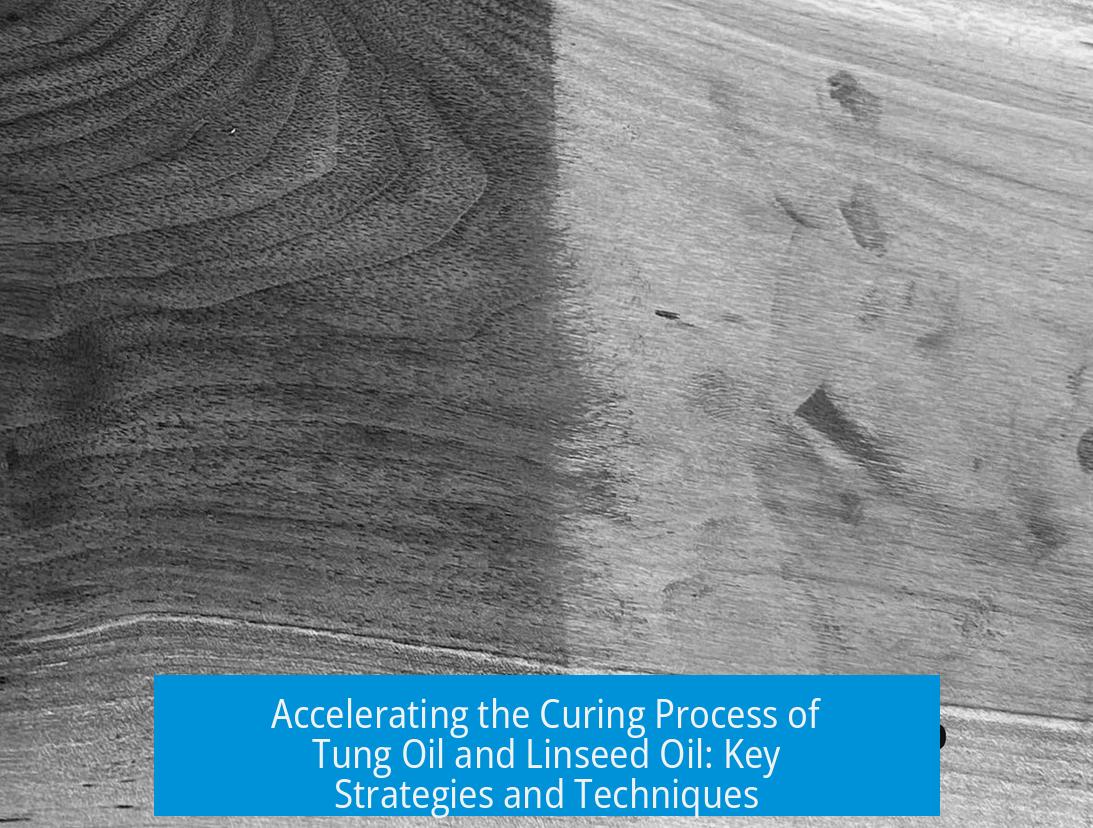Accelerating the Curing of Drying Oils: Tung Oil and Linseed Oil

Accelerating the curing of drying oils such as tung oil and linseed oil requires a combination of physical and chemical approaches, including controlled oxygen exposure, temperature adjustments, airflow management, use of light sources, chemical accelerators (siccatives), and application techniques. Each factor influences the curing process differently and should be optimized carefully to achieve faster and effective drying without compromising the properties of the oil film.
Understanding the Curing Mechanism of Drying Oils
Drying oils cure primarily through autoxidation. They contain polyunsaturated fatty acids that react with oxygen, forming cross-linked polymers creating a solid film. The reaction involves two major steps:
- Oxygen fixation on the fatty acid chains.
- Formation of cross-links, likely involving epoxide bridges and loss of water.
The rate-limiting step in this reaction is not clearly established. It might be either oxygen uptake or subsequent chemical transformations. Determining the controlling step is critical for deciding which method best accelerates curing.
1. Oxygen Concentration
Increasing the oxygen concentration can enhance the curing speed under ideal conditions. In experiments with pure oxygen environments, curing time reduces from about 80 hours in air to approximately 1 to 1.5 hours under 100% oxygen.
However, practical application faces challenges:
- If the rate-limiting step is not oxygen fixation, increasing oxygen may have minimal impact.
- Elevated oxygen levels raise the risk of spontaneous combustion, especially with rags soaked in tung oil.
Therefore, while oxygen enrichment can accelerate curing drastically, it poses safety risks and practical limitations. Typical drying in air may thus be slower but safer.
2. Temperature Control
Raising temperature can speed the autoxidation reaction by increasing molecular activity. Yet, moderate temperature changes (10–20 °C) may not be sufficient to produce noticeable acceleration because the reaction follows Arrhenius kinetics and requires substantial increases to make a difference.
Important considerations include:
- The glass transition temperature (Tg) of the polymerized oil film is near 50 °C. Exceeding this transforms the film from a glassy to a rubbery state, weakening mechanical properties.
- Excessive heat can degrade the oil or substrate.
- Using infrared (IR) or microwave irradiation provides targeted heating and accelerates curing without excessive bulk temperature rise.
Infrared and microwave exposure is an effective and controlled method to enhance drying speed. Ultraviolet (UV) light, conversely, may cause polymer degradation and is not recommended.
3. Airflow and Volatile Component Management
Drying oils often include volatile solvents or additives. Increasing airflow over the surface helps remove these volatiles faster, raising the relative concentration of the drying oil.
This effect promotes:
- Enhanced oxidation due to more reactive oil at the interface.
- More rapid solvent evaporation and film formation.
Still, airflow alone does not speed the chemical curing step but aids in faster solvent loss and overall drying sensation.
4. Use of Light Sources: UV, IR, and Microwaves
| Light Type | Effect on Curing | Considerations |
|---|---|---|
| UV Light | Likely harmful, causes degradation of epoxide cross-links. | Not recommended for accelerating curing. |
| Infrared (IR) Light | Provides gentle heating, accelerates curing rate. | Effective for controlled acceleration. |
| Microwave Irradiation | Simulates heat source; speeds reaction by thermal action. | Useful alternative method to traditional heating. |
5. Chemical Accelerators (Siccatives)
Siccatives, or “dryers,” are metal salts that catalyze drying via redox cycling and free-radical generation facilitating cross-linking. Historically, cobalt-based compounds have been used extensively.
Key points include:
- Cobalt salts (naphthenates or octoates) are highly effective drying agents.
- Combinations often include calcium and zirconium salts to enhance performance and reduce toxicity.
- Lead compounds were used previously but are now replaced due to health concerns.
- Commercial drying agents exist—for example, the product “terebine” combines cobalt, calcium, and lead or zirconium derivatives.
Incorporating these accelerators into drying oil formulations significantly reduces curing time and enhances film hardness.
6. Application Techniques
Proper application influences drying rates by affecting penetration and spreading. Techniques include:
- Applying thin coats encourages better oxygen penetration and faster curing.
- Multiple thin layers allow the oil to soak into wood pores effectively.
- A final slightly thicker coat provides a protective film without compromising drying speed.
These methods prevent prolonged wetness and reduce tackiness.
Summary of Effective Strategies for Accelerating Drying Oils:
- Oxygen enrichment accelerates curing but increases fire risk and requires controlled environments.
- Temperature increases aid reaction rates if carefully managed below polymer glass transition temperatures.
- Airflow helps remove solvents, improving drying sensations without affecting chemical curing critically.
- Infrared and microwave irradiation provide efficient heating methods to speed curing.
- Chemical accelerators (siccatives) such as cobalt salts dramatically shorten drying times.
- Thin multiple coats and correct application enhance oxygen diffusion and curing uniformity.
How does pure oxygen affect the curing speed of drying oils like tung or linseed oil?
Pure oxygen can significantly speed curing, reducing time from around 80 hours to 1-1.5 hours. However, the reaction rate might be limited by other steps, so higher oxygen doesn’t always equal faster curing. Also, combustion risk with oily rags rises under high oxygen.
Can heating oil speed up the curing process, and are there temperature limits to consider?
Heating helps but only above certain points. Small increases (10-20°C) have little effect. Going beyond about 50°C risks softening the polymer, which is unwanted. IR and microwaves also help by supplying heat more efficiently.
Why is airflow important for drying oils during curing?
Increasing airflow removes volatile solvents faster. This raises the concentration of the oil on the surface, promoting quicker curing. Air circulation helps but does not speed the chemical reaction directly.
Are UV or IR lights useful in accelerating the curing of drying oils?
IR light can aid curing by warming the oil. Microwaves also help as a heat source. UV light, however, may cause degradation and slow curing due to breakdown of the chemical bonds formed.
What are chemical dryers or siccatives, and how do they speed up curing?
Chemical dryers contain metals like cobalt, calcium, or zirconium. They catalyze the oxidation and polymerization of oils, speeding cure times. Traditional dryers often used lead but now favor less toxic alternatives.





Leave a Comment